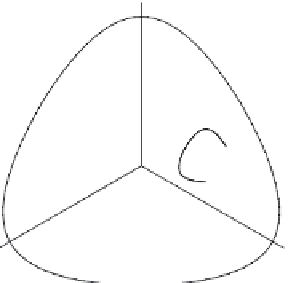Geoscience Reference
In-Depth Information
σ
z
q
failure
b.
elastic region
failure
kinematic
yield surface
stress path
p'
a.
σ
y
σ
x
p
effective stress plane
Fig. 6.2. Outline of kinematic hardening soil model in(a)
q
:
and (b)deviatoric stressplane
which travels around with the recent stress history, which represents the extent of the
elastic region for the soil. In Figure 6.2a this elastic region is a 'wedge' representing a
small range of values of mobilised friction; in Figure 6.2b it is a 'bubble' which floats
around. The detailed implementation of kinematic hardening plasticity needs additional
ingredients: for sands, the strength depends on density and mean stress level; a flow
rule is required to define the way in which plastic strains develop when the stress state
is engaging with the kinematic yield surface shown in Figure 6.2. Severn-Trent sand
(GajoandMuirWood,1999a,b)isacompletesoilmodelwhichmakescurrentstrengtha
variabledependentonstateparameter(BeenandJefferies,1985)anddescribessoftening
ofdensesandswhileretainingasimplemonotonicdistortionalhardeningrelationship.In
an undrained cyclic triaxialtestitshows progressive pore pressurebuild-upand eventual
liquefaction.
3. Fabric, soil stiffness and laboratory geophysics
Themovingyieldsurfacedefinesthecurrentregionofstressspacewhichcanbereached
elastically as a result of the recent stress history. Once the stress path engages with this
surfaceandstartstopushitaround,irrecoverabledeformationswilloccurandthe'fabric'
ofthesoilwillchange.Thegeometricfabricdescribestheorientationofcontacts,andthe
kineticfabricdescribeshowthesecontactsareactuallybeingusedtocarryforcesthrough
the soil. One geometric fabric can carry many different external loads: kinetic fabric
can change much more rapidly than orientation fabric which requires significant relative
movement of particles. The fabric of soils can only be seen incompletely—radiographic
techniques reveal local variations in density (Muir Wood, 2002) and photographic tech-
niques can monitor movement of individual particles (White et al., 2003). The way in
which stress is carried through the soil by chains of particles can only be seen through
numerical analysis. These force chains are anisotropic and the stiffness properties of the
soil will alsoingeneral be anisotropic and evolve with stresshistory.



























